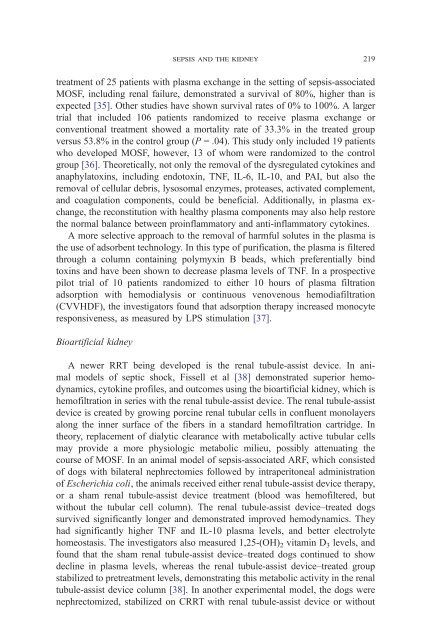sepsis and the kidney.pdf - SASSiT
sepsis and the kidney.pdf - SASSiT
sepsis and the kidney.pdf - SASSiT
Create successful ePaper yourself
Turn your PDF publications into a flip-book with our unique Google optimized e-Paper software.
treatment of 25 patients with plasma exchange in <strong>the</strong> setting of <strong>sepsis</strong>-associated<br />
MOSF, including renal failure, demonstrated a survival of 80%, higher than is<br />
expected [35]. O<strong>the</strong>r studies have shown survival rates of 0% to 100%. A larger<br />
trial that included 106 patients r<strong>and</strong>omized to receive plasma exchange or<br />
conventional treatment showed a mortality rate of 33.3% in <strong>the</strong> treated group<br />
versus 53.8% in <strong>the</strong> control group (P = .04). This study only included 19 patients<br />
who developed MOSF, however, 13 of whom were r<strong>and</strong>omized to <strong>the</strong> control<br />
group [36]. Theoretically, not only <strong>the</strong> removal of <strong>the</strong> dysregulated cytokines <strong>and</strong><br />
anaphylatoxins, including endotoxin, TNF, IL-6, IL-10, <strong>and</strong> PAI, but also <strong>the</strong><br />
removal of cellular debris, lysosomal enzymes, proteases, activated complement,<br />
<strong>and</strong> coagulation components, could be beneficial. Additionally, in plasma exchange,<br />
<strong>the</strong> reconstitution with healthy plasma components may also help restore<br />
<strong>the</strong> normal balance between proinflammatory <strong>and</strong> anti-inflammatory cytokines.<br />
A more selective approach to <strong>the</strong> removal of harmful solutes in <strong>the</strong> plasma is<br />
<strong>the</strong> use of adsorbent technology. In this type of purification, <strong>the</strong> plasma is filtered<br />
through a column containing polymyxin B beads, which preferentially bind<br />
toxins <strong>and</strong> have been shown to decrease plasma levels of TNF. In a prospective<br />
pilot trial of 10 patients r<strong>and</strong>omized to ei<strong>the</strong>r 10 hours of plasma filtration<br />
adsorption with hemodialysis or continuous venovenous hemodiafiltration<br />
(CVVHDF), <strong>the</strong> investigators found that adsorption <strong>the</strong>rapy increased monocyte<br />
responsiveness, as measured by LPS stimulation [37].<br />
Bioartificial <strong>kidney</strong><br />
<strong>sepsis</strong> <strong>and</strong> <strong>the</strong> <strong>kidney</strong> 219<br />
A newer RRT being developed is <strong>the</strong> renal tubule-assist device. In animal<br />
models of septic shock, Fissell et al [38] demonstrated superior hemodynamics,<br />
cytokine profiles, <strong>and</strong> outcomes using <strong>the</strong> bioartificial <strong>kidney</strong>, which is<br />
hemofiltration in series with <strong>the</strong> renal tubule-assist device. The renal tubule-assist<br />
device is created by growing porcine renal tubular cells in confluent monolayers<br />
along <strong>the</strong> inner surface of <strong>the</strong> fibers in a st<strong>and</strong>ard hemofiltration cartridge. In<br />
<strong>the</strong>ory, replacement of dialytic clearance with metabolically active tubular cells<br />
may provide a more physiologic metabolic milieu, possibly attenuating <strong>the</strong><br />
course of MOSF. In an animal model of <strong>sepsis</strong>-associated ARF, which consisted<br />
of dogs with bilateral nephrectomies followed by intraperitoneal administration<br />
of Escherichia coli, <strong>the</strong> animals received ei<strong>the</strong>r renal tubule-assist device <strong>the</strong>rapy,<br />
or a sham renal tubule-assist device treatment (blood was hemofiltered, but<br />
without <strong>the</strong> tubular cell column). The renal tubule-assist device–treated dogs<br />
survived significantly longer <strong>and</strong> demonstrated improved hemodynamics. They<br />
had significantly higher TNF <strong>and</strong> IL-10 plasma levels, <strong>and</strong> better electrolyte<br />
homeostasis. The investigators also measured 1,25-(OH) 2 vitamin D 3 levels, <strong>and</strong><br />
found that <strong>the</strong> sham renal tubule-assist device–treated dogs continued to show<br />
decline in plasma levels, whereas <strong>the</strong> renal tubule-assist device–treated group<br />
stabilized to pretreatment levels, demonstrating this metabolic activity in <strong>the</strong> renal<br />
tubule-assist device column [38]. In ano<strong>the</strong>r experimental model, <strong>the</strong> dogs were<br />
nephrectomized, stabilized on CRRT with renal tubule-assist device or without
















